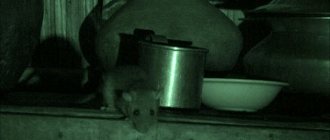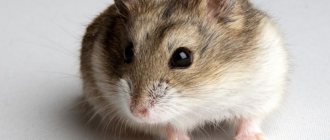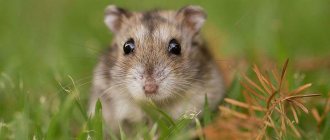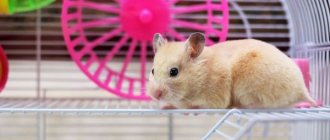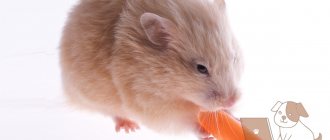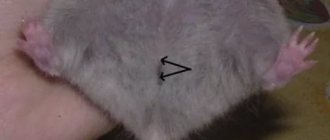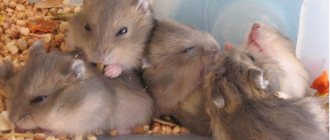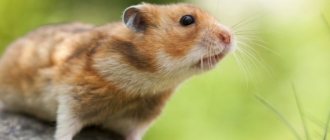Not many owners of small furry rodents have thought about how hamsters see. Different breeds differ not only in size, weight and color. Dzungarians see the world in black and white. Other breeds can see the world around them more clearly. Wild hamsters are more vigilant, as this helps them survive outside the comfort of their home. Insufficiently sharp vision is compensated by developed sensory organs. Let's take a closer look at how hamsters see our world.
Interesting facts about hamsters
Hamsters are wonderful pets. These are playful, active, cute rodents who enjoy care, affection, and games with their owner. About 25 breeds of animals have been bred in the world, differing in size and appearance. Many amazing and unexpected stories can be told about large European, tiny dwarf, wild American, and popular Djungarian hamsters. Below are the most amusing and interesting facts about these wonderful and cute pets.
- The largest breed is the European hamster. The length of its body reaches 30 centimeters. And the smallest rodent is the dwarf hamster. It rarely grows more than 10 centimeters. But they live much longer than other breeds: up to four years!
- The animals have a unique ability: they can store uneaten or found food behind their cheeks for quite a long time in special bags in order to eat it later. Animals can easily hold food in their mouths, the weight of which reaches 20% of their body weight!
- The most popular and widely bred breed is the Syrian hamster, which is brown in color with a golden tint.
- Some breeders call male rodents hogs, and females sows. Although their pets have nothing to do with pigs.
- Hamsters have been known for a long time. This biological species was first discovered in the semi-deserts of Syria. But the animals got their name from the German word “hamstern”, which means “to accumulate, store up”.
- Hamsters' vision is poor and colorless. Therefore, in studying the world around them, they rely more on a keen sense of smell and excellent hearing.
- Rodents have special glands on their bodies that secrete an odorous secretion. Animals use this liquid to mark the road.
- Hamsters' incisors, like those of all other rodents, grow throughout their lives and require grinding down with rough food. And the cubs are already born with teeth.
- Animals can climb mountains to a height of up to four kilometers. They are also excellent swimmers, drawing in air with their cheek pouches and using them as air mattresses.
- The owner must build a running wheel in the pet’s cage. The hamster is so nimble and agile that it can cover a distance of 10 kilometers in a wheel overnight!
- Almost all Syrian hamsters existing today are descendants of a single female. In 1930, she gave birth to 12 cubs, giving birth to the breed.
- The habitat of wild rodents is rapidly declining, so many populations are on the verge of extinction. The Syrian hamster and its close relative, Newton's hamster, are already listed in the Red Book as an endangered species.
- Sex cells from males of the Chinese breed are used in pharmaceuticals to produce drugs against serious diseases, including oncology.
- In Vietnam, it is legally prohibited to breed and keep hamsters as pets. They are believed to carry many dangerous infections. Disobedience to the law results in heavy fines.
- Representatives of the forest North American species love to store shiny objects they find in their burrows: buttons, brooches, beads, coins. When they take a thing, they usually put a pebble or a stick in its place, as if exchanging.
- Hamsters just look stupid and awkward. In fact, they are smart, agile and quick-witted creatures. Pets respond to a nickname, remember their cage neighbors and relatives, and can easily learn several tricks.
- One year of a hamster's life is equal to almost 25 human years. It's a pity that furry pets live so short.
- Pregnant females of some dwarf breeds have the ability to delay childbirth if they have not yet nursed cubs from a previous litter.
- The assumption that hamsters are social animals is incorrect. In fact, they prefer to live alone and do not tolerate other individuals nearby. If you place several males in one cage, a fight with a bloody and even fatal outcome is inevitable.
- It is also incorrect to believe that hamsters eat only plant foods. In their natural habitat, animals often feast on insects, and at home they can be given boiled chicken or lean fish.
What kind of vision do hamsters have?
You can often come across the opinion that hamsters have poor eyesight. Nature has endowed these rodents with sufficient vigilance to notice danger in time. However, they do not see a clear picture. These animals are shortsighted. Therefore, even at a short distance they can view objects in a blurry form. Animals see more or less clearly at a distance of up to 1 m.
Depending on what species the rodent belongs to, its viewing angle depends. Thus, one of the largest representatives of the hamster family in terms of body size, the Syrian or Central Asian hamster, has larger eyes than, for example, the small Djungarian. Therefore, his field of vision is wider.
Did you know? To make a supply, the hamster stuffs food into organs specially designed for this purpose - the cheek pouches. In them, the animal can save food, which weighs 2 times more than its entire body.
At the same time, visual acuity is the same in all breeds, be it a “jungarian” or an Angora fluffy. True, there is an opinion that wild animals see a little better, since they need to protect themselves from enemies and dangers, as well as get their own food every day. As for the color spectrum, hamsters distinguish between yellow and green.
Cage equipment
We supply the cage with attractions for your furry pet. There is a large selection of toys for rodents on sale. Be sure to install a wheel whose dimensions correspond to the miniature size of the pet (about 16 cm). In addition to the wheel, you should equip your pet's house with tunnels and wooden branches on which he can climb. You can put a hammock and various ladders.
The cage for Djungarian hamsters should have a feeder and water bowl. There are different models of drinkers and feeders in stores. They differ in the material from which they are made. It is better to choose a ceramic feeder. It is heavy and your pet will not turn it over. As for the drinking bowl, it is better to opt for a model that is attached to the wall of the cage. We change the water in the drinking bowl daily. Since the natural habitat of rodents is the desert, Djungarian hamsters do not drink often. It is not necessary to fill the drinker full.
Well, the last thing worth purchasing is a bathtub. Rodents do not swim, and water treatments are contraindicated for Djungarian hamsters. But in a sand bath he enjoys cleaning his fur.
If you're traveling, you'll also need a carrier.
Make sure you have a hiding place where your furry pet can hide supplies, because the instinct to stock up on food has not disappeared in domesticated animals.
Interesting facts about golden hamsters
Animals of this breed living in captivity are very friendly and not at all aggressive. This is what distinguishes them from their wild counterparts. But at the same time, they skillfully guard their territory and will not allow strangers to be on it. For them there is no concept of family ties.
These animals prefer to live alone and are capable of killing a weaker hamster. Therefore, owners should keep them alone.
Scientists have proven that Syrian hamsters can eat almost anything. Therefore, in addition to seeds and grains or fruits, they also need to eat animal protein. In the wild, they can eat insects, carrion, or even hunt other small animals. In addition, sometimes females can destroy their offspring, which their owners try to prevent in captivity.
At home, these animals should be given lean and thoroughly cooked poultry or fish. Otherwise, these small and usually calm animals become quite aggressive and can bite.
Can they see in the dark
The visual features of the described rodents are explained by their way of life in the wild. They are born and spend most of their time in a burrow underground. They are nocturnal. In search of food, animals emerge from their underground homes after dark. At this time they see more clearly. But sunlight blinds them and causes discomfort. Therefore, during the daytime, rodents try not to stick their noses out of the hole.
Important! Due to the fact that the hamster is nocturnal, experienced breeders advise purchasing this pet in the evening. It is during this period that the animal is most active, and it is possible to more accurately determine whether it is healthy or not.
Some more exciting facts about hamsters
- Syrian hamsters live on their own; they are solitary creatures and need their own space. If they are placed with other hamsters, they will become very aggressive and may even kill them.
- Hamsters' natural habitat is declining worldwide. As a result, the hamster population is now under threat, with some species on the verge of extinction.
- Hamsters do not have very good eyesight, they are very short-sighted and rely more on their sense of smell. Hamsters have scent glands, with which they leave marks on stones and other objects, thereby marking their path.
- Hamsters are color blind, i.e. they are colorblind
- When they are scared they may bite, but hamsters are generally kind and gentle creatures and love to play with their owners.
- Hamsters are quite easy to train to do various tricks and respond to their name.
- Hamsters typically live between two and three years, however, one year of human life is equivalent to approximately 25 years of a hamster's life!
- A male hamster is sometimes called a hog, and a female is sometimes called a sow.
Comments
It’s a pity for the man (But it looks like there’s no help for him. Is his fur normal? Before he died, my Syrian was kind of disheveled, as if he was unkempt.
I would take it to the veterinarian and give a relief injection (there is no need to prolong the suffering(
They live for 2-3 years, one hamster died two years later, my daughter and I sat next to him all night. He began to slowly get colder, we wrapped him up and tried to warm him up, then I realized that he was dying and we were just nearby, in the morning he died and we My daughter and I went to bury him and chose a beautiful place. In general, the plant doesn’t have any more animals, I feel sorry for them
Boring monochrome or how hamsters see the world
The quality of vision of hamsters of different breeds does not differ. But the viewing radius may change. Syrians have larger eyes than Djungarians, so the viewing angle is greater while maintaining the same sharpness of perception of things and a set of distinguishable colors.
Hamsters are myopic creatures, unable to clearly perceive objects at a distance of more than a meter. Animals see the world as blurry silhouettes with distinguishable contours. They are able to distinguish shades of yellow and green.
Hamsters' vision is not very sharp, but the animals are adapted to survival. The quality of vision is correlated with living conditions and does not prevent them from leading an active and safe lifestyle.
Such features of visual perception are associated with the lifestyle of animals. Babies are born in a hole in complete darkness. Rodents spend most of their lives in the same conditions. Bright sun rays are irritants. When in a sunlit area, hamsters squint. Therefore, the animals avoid interaction with the open sun and spend most of the day sitting in a hole or house.
How much does it cost to get a Djungarian?
Under natural conditions, adult hamsters live alone. Therefore, it is not recommended to have a pair of dzhungarikas - a female and a male. Of course, this will allow you to observe how pets interact with each other. However, hamsters do not really like to share their territory with someone. If you add a second dwarf to a mature individual, a conflict will occur between them. The one who was settled in the cage first will attack the newcomer in order to protect his possessions. In such conditions, a weaker pet may die.
One way to keep two or more Djungarian hamsters at home is to raise them together from an early age.
Some people manage to place a female with a sexually mature male. To do this, it is important to create ideal conditions for both - provide each with their own house, feeder, wheel, and for the first time install a lattice partition in the middle of the cage.
The Dzungarians will see each other, but will not be able to fight. In such conditions, they will gradually get used to the neighborhood and make friends. When this happens, the dividing partition can be removed.
Do not pick up small dungarian hamsters, otherwise you will feed them yourself
Female Djungarian hamsters usually give birth to 4 to 6 babies. On the fifth day after birth, babies acquire soft fluff; on the 10th day, the fur is already quite thick; by this moment the eyes also open. On the 20th day, the offspring of dwarf hamsters can be separated from their mother. To the pet owner
It is worth knowing that the cubs do not feel the danger of falling from a height: when they reach the edge of a shelf or table, they move further and can be very seriously injured when falling. Therefore, the cage should always be closed.
Newborn babies do not squeak only when they feel proper care from their mother. They begin to make shrill sounds when the mother does not feed or lick them. When going out to get food, the furry mother always covers the “kindergarten” with soft bedding.
Care
Cleaning the cage
The unpleasant smell of the cage will not bother you if you regularly clean it once every 1-1.5 weeks. Place the hamster in the carrier. Remove the dirty litter, leaving a small amount (this will make the hamster feel more comfortable), and add fresh litter. Once a month, carry out wet cleaning, washing the bottom of the cage with water and laundry soap.
Bathing
Never wash your hamster in water! If you notice that your pet's coat is matted and not shiny, give him a sand bath. To do this, purchase a special bathing suit (a three-liter jar will do) and sand for chinchillas. Pour some sand into the bathing suit and throw in the dzhungarika. Soon you will be watching him wallow in the sand and clean his skin.
As you can see, caring for dzhungarikas is not very difficult. Clean the cage regularly, provide your hamster with access to water and fresh food and, of course, play with him regularly. These simple measures will ensure your pet has a happy and healthy life!
Parasitic, fungal, dermatological diseases and symptoms
Hamsters, regardless of breed, often suffer from parasitic and fungal diseases. Djungarians are diagnosed with lichen, dermatophytosis, and trichomoniasis. The main manifestations of mycoses are severe itching, restlessness, deterioration of the coat, the appearance of rashes on the body, scratching, wounds, and long-term non-healing ulcers. With dermatophytosis, the skin acquires a yellowish tint and is very flaky. If treatment is not started, pathogenic flora penetrates into wounds and scratches, which provokes inflammation in various structures of the dermis.
Important! If a hamster is sick with a parasitic or fungal disease and is kept in the same cage with other rodents, immediately isolate the sick animal and disinfect the pet’s home.
Hamsters are susceptible to dermatitis, dermatoses of various etiologies, as well as allergies. Deterioration in the condition of the coat, partial or complete baldness is provoked by frequent stress, deficiency of vitamins, minerals, external parasites, fungi, and substances of a toxic nature.
Your veterinarian will tell you how to treat mycoses. The pet will be prescribed fungicidal, antibacterial agents, solutions (Miramistin, Chlorhexidine), as well as antiparasitic shampoos.
Temperature for keeping hamsters
Ideally 17-20 °C. Air humidity 40 - 70 percent. High humidity negatively affects the heat exchange of living beings. Dry air is also dangerous - if the cage is located less than 2 meters from the battery. As a result, the animal may develop metabolic disorders.
A hygrometer will help keep the situation under control. Think about your pet in advance when ventilating the room so as not to leave him in a draft.
Before getting a hamster, you need to think about its needs in advance. The first thing you need to do is buy a suitable home for your future pet. Many people rely on the opinion of the seller at the pet store, but in vain. After all, the wrong choice not only threatens constant stress for the rodent, but can also lead to injury.
What helps a hamster learn about the world?
The rodent's poor visual acuity is compensated by other sensory organs. We are talking about three feelings:
- touch;
- smell;
- hearing
Vibrissae help hamsters navigate the area. These are antennae that are located near the nose. They are located in areas where there is a concentration of nerve endings. Thanks to the vibrissae, the animal can scan the surrounding space and sense obstacles that arise on its way.
Another important sense that helps a hamster successfully survive and reproduce is smell. With the help of special scent glands that are responsible for it, the animal determines who is in front of it - a female or a male, an enemy or a friend. A hamster can easily identify the smells of other animals. Therefore, if the owner, for example, has recently interacted with a cat, then the pet will avoid him, since the cat’s smell will cause fear in him.
Important! Since hamsters are nocturnal animals, in order for their life to be comfortable, the cage should be installed in a quiet place. This will give them the opportunity to sleep during the daytime.
Sense organs of a guinea pig
Read first: Encyclopedia reference book: All about pigs
The cochlea of the inner ear in a guinea pig has four turns, but in mice and rats, even in humans there are only two and a half. Thus, guinea pigs have relatively more space for auditory cells, resulting in particularly good hearing. If a person can perceive sounds from 20,000 Hz (child) to 15,000 Hz (adult), then guinea pigs perceive sounds with a frequency of up to 33,000 Hz.
Smell
Guinea pigs' sense of smell is focused primarily on contact with each other and on sexual behavioral norms. For example, their urine plays an important role in marking. Thus, males who are ready for mating inject urine, females who are not in heat, along with hostile behavior, use scent to demonstrate to the male that they are not ready for mating. Guinea pigs rely primarily on their sense of smell. Guinea pigs in a social community recognize each other by smell. This applies not least to the loss after re-identification of young animals. It was noted that this group-specific identification, after repetition for several days, disappears in adult animals. Marking territory with secretions, as well as urine, explains why guinea pigs feel at ease in their familiar environment and are very restless and insecure in an unfamiliar one. This later manifests itself in their timid behavior. Compared to humans, guinea pigs have a heightened sense of smell. It is about a thousand times more developed than in humans. Thus, they perceive a variety of odors that are not noticed by people at all, and therefore can be excited for various reasons. Guinea pigs are accustomed to living and playing in small groups. Likewise, when eating, guinea pigs’ sense of smell plays a very important role in distinguishing between healthy and unhealthy food. The same applies to identifying different individuals.
Vision
Due to the position of their eyes, guinea pigs are able to look both forward and to the sides without turning their heads. Thus, they have a relatively wide field of vision, which is especially important for protection from their natural enemies in the wild. Guinea pigs can at least distinguish between the colors red, yellow, green and blue. This also plays a role when eating.
Touch
Tactile hairs around the mouth and nose help guinea pigs determine in the dark whether it is possible to penetrate this hole or whether there is an obstacle in the way. Gustatory perception When guinea pigs' sense of smell does not allow them to clearly identify or approve certain types of food, they call on their sense of taste to help. In this case, along with instinctively conditioned reactions, previously accumulated experience plays a role, for example, in distinguishing between good and bad food. This means that guinea pigs prefer sweet food to salty food. However, they do not refuse bitter things either. And among guinea pigs there are individual taste preferences, which are manifested in the fact that individual individuals often prefer completely different foods as treats.
How hamsters look at the world
Perhaps one of the most interesting topics to discuss about hamsters is their vision of the world. The very existence of such a question raises the assumption that our views differ. This is actually true.
Hamsters are highly myopic
Now let's figure it out one by one, how do hamsters see? Since these animals show their main activity at night due to natural predators, they do not need well-developed daytime vision. Hamsters have highly developed myopia; they see relatively clearly only nearby objects, while the rest of the world is blurred and only outlines can be discerned. This way they can navigate well and not collide with anything (all attention is directed to a small area of the terrain).
As for light perception, it is developed rather poorly, the shades of red day are indistinguishable, but orange and green are quite. This feature appeared due to the need to get food for themselves at night, so if you want to impress a hamster, add yellow and green tones to their life.
Here's a small example of how hamsters see:
